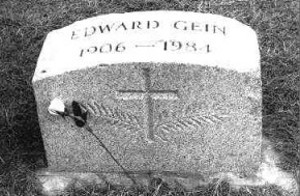
Norman Bates, Leatherface… they’re just characters, iconic villains from popular movies. But their genesis lies in truth. For, back in 1957 at a small farm in Wisconsin, a local eccentric was arrested and his crimes uncovered. These were not crimes from some splatter flick or horror novel, these were the evil deeds of an all-American, some would say kind, man that lived among the people, but with a secret life that no one would suspect. When the fifty-one year old’s home was invaded by the authorities, the carnage which they would witness would forever change the face of horror, and leave a deep scar on the Leave it to Beaver façade of America.
The disappearance of store owner Bernice Worden would lead local police to a small farm in Plainfield, Wisconsin, where they would find the decapitated and gutted body of Worden hanging upside down. Upon investigation it was later revealed that Worden had been shot close range in the head before having her ribcage split in two and her torso and head removed. As they began a search of the house, further atrocities were uncovered, including a shoebox full of preserved female genitals, a soup bowl made from a human skull, lampshades from skin and organs in the refrigerator. It was also suspected that he had used skin as masks, which would later influence the ’70’s classic The Texas Chainsaw Massacre.
 From his victims he had also designed a ‘female suit,’ stitched together Frankenstein-style, complete with breasts. He had also exhumed countless bodies from a nearby cemetery, as his obsessions with death and the macabre grew worse. One of these bodies was that of his mother, Augusta, who had passed away twelve years earlier. The concept of keeping a mother’s corpse and interacting with it would become a major theme in Robert Bloch’s 1959 novel Psycho, adapted into a major motion picture by Alfred Hitchcock the following year. The story’s antagonist, the emotionally disturbed Norman Bates, would become a major influence on many slasher villains.
From his victims he had also designed a ‘female suit,’ stitched together Frankenstein-style, complete with breasts. He had also exhumed countless bodies from a nearby cemetery, as his obsessions with death and the macabre grew worse. One of these bodies was that of his mother, Augusta, who had passed away twelve years earlier. The concept of keeping a mother’s corpse and interacting with it would become a major theme in Robert Bloch’s 1959 novel Psycho, adapted into a major motion picture by Alfred Hitchcock the following year. The story’s antagonist, the emotionally disturbed Norman Bates, would become a major influence on many slasher villains.
As with many serial killers or criminals of a similar, twisted nature, Gein was the target of much psychical and psychological abuse as a child, both from his abusive, alcoholic father and overbearing mother. Augusta would preach about the evils of women and would often quote from the bible. More importantly, she was never satisfied with either of her two sons, no matter how hard they tried, which provided both Edward and his older brother, Henry, with an unhappy childhood. His brother would pass away in 1944, allegedly due to a fire in the bushes surrounding the property, though a police report would state that injuries were found to his head and no burns were present. The last family member to die was his mother the following year, leaving Ed alone to tend the farm. His crimes would remain undiscovered until that fateful night when the police would search his property for Worden.
 Even more than Charles Manson, Gein has had a massive impact on popular culture, providing the groundwork for Psycho and almost every serial killer movie that would follow. Other films to borrow heavily from his life story are Deranged, The Silence of the Lambs and, of course, The Texas Chainsaw Massacre. There have also been numerous biopics, some TV movies and others generic slashers, including the 2007 movie Ed Gein: The Butcher of Plainfield, starring Kane Hodder. The music industry has also referenced him in its work, with Gidget Gein (who passed away last September), former bassist for shock rockers Marilyn Manson, adopting his surname, and a punk group from New York called Ed Gein. There are also various sites and books dedicated to him, proving that even serial killers can become stars in their own right. Gein passed away from heart failure on July 26th, 1984, at the age of 77.
Even more than Charles Manson, Gein has had a massive impact on popular culture, providing the groundwork for Psycho and almost every serial killer movie that would follow. Other films to borrow heavily from his life story are Deranged, The Silence of the Lambs and, of course, The Texas Chainsaw Massacre. There have also been numerous biopics, some TV movies and others generic slashers, including the 2007 movie Ed Gein: The Butcher of Plainfield, starring Kane Hodder. The music industry has also referenced him in its work, with Gidget Gein (who passed away last September), former bassist for shock rockers Marilyn Manson, adopting his surname, and a punk group from New York called Ed Gein. There are also various sites and books dedicated to him, proving that even serial killers can become stars in their own right. Gein passed away from heart failure on July 26th, 1984, at the age of 77.

6 Responses to REAL-LIFE SLASHERS – Ed Gein